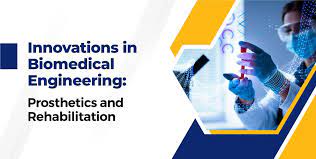Introduction
Biomedical engineering and regenerative medicine stand at the forefront of cutting-edge technological advancements, offering transformative solutions for healthcare challenges. This article explores the latest innovations in biomedical engineering and regenerative medicine, highlighting breakthroughs that have the potential to revolutionize medical treatments and improve the quality of life for countless individuals.
**1. 3D Bioprinting: Building Organs Layer by Layer
One of the most groundbreaking innovations in biomedical engineering is 3D bioprinting, a technology that enables the fabrication of living tissues and organs layer by layer. This method holds immense promise for regenerative medicine, as it allows for the creation of customized organs and tissues tailored to individual patient needs. The ability to replicate complex biological structures marks a significant leap forward in the field.
**2. Gene Editing Techniques: CRISPR-Cas9
The advent of CRISPR-Cas9 gene-editing technology has revolutionized biomedical research and regenerative medicine. This powerful tool allows scientists to precisely modify genes, opening the door to potential treatments for genetic disorders. The ability to edit genes with unprecedented accuracy holds vast implications for developing targeted therapies and personalized medicine.
**3. Nanotechnology for Drug Delivery
Nanotechnology has emerged as a game-changer in drug delivery systems. Tiny nanoparticles can be engineered to carry medications directly to targeted cells or tissues, minimizing side effects and enhancing treatment efficacy. This innovation has significant implications for regenerative medicine, providing a more targeted and efficient means of delivering therapeutic agents to promote tissue regeneration.
**4. Bionic Prosthetics and Neural Interfaces
Advancements in bionic prosthetics and neural interfaces have transformed the lives of individuals with limb loss or paralysis. Biomedical engineers have developed prosthetic limbs that can be controlled with neural signals, offering users more natural and intuitive movement. This integration of technology with the human nervous system represents a milestone in enhancing the quality of life for those with physical impairments.
**5. Organ-on-a-Chip Technology
Organ-on-a-chip technology involves creating microscale models of human organs that mimic their physiological functions. These microdevices offer a platform for studying diseases, testing drug responses, and understanding organ interactions in a controlled environment. This innovation accelerates drug development processes and provides insights into personalized medicine strategies.
**6. Stem Cell Therapies
Stem cell therapies continue to be a focal point in regenerative medicine. Scientists are exploring the potential of various stem cell types, including induced pluripotent stem cells (iPSCs), to regenerate damaged tissues and organs. These therapies hold promise for treating conditions such as spinal cord injuries, heart disease, and degenerative disorders.
**7. Artificial Intelligence in Diagnostics and Treatment Planning
The integration of artificial intelligence (AI) in biomedical engineering has revolutionized diagnostics and treatment planning. AI algorithms can analyze vast datasets, identify patterns, and assist healthcare professionals in making more accurate diagnoses and treatment decisions. This innovation streamlines medical processes and enhances the precision of regenerative medicine interventions.
**8. Bioelectronic Medicine
Bioelectronic medicine involves the use of electrical stimulation to modulate the body’s neural pathways. This innovative approach has shown promise in treating various conditions, including inflammatory disorders and neurological diseases. By interfacing with the body’s electrical signaling, bioelectronic medicine offers a novel avenue for therapeutic interventions.
**9. Innovative Materials for Implants
Biomedical engineers are continually developing innovative materials for medical implants that enhance biocompatibility and durability. From biodegradable scaffolds for tissue regeneration to advanced materials for orthopedic implants, these innovations aim to improve the success rates of implant procedures and reduce the risk of complications.
**10. Telemedicine and Remote Monitoring
The integration of telemedicine and remote monitoring technologies has expanded the reach of healthcare services. Patients undergoing regenerative medicine treatments can benefit from remote monitoring, allowing healthcare providers to track progress, adjust treatment plans, and offer timely interventions. This innovation enhances accessibility and continuity of care.
Conclusion
The innovations in biomedical engineering and regenerative medicine are reshaping the landscape of healthcare. From 3D bioprinting and gene editing to nanotechnology and bioelectronic medicine, these advancements hold the promise of more effective treatments, personalized interventions, and improved patient outcomes. As researchers and engineers continue to push the boundaries of what is possible, the future of medicine looks increasingly bright, with transformative technologies that have the potential to redefine the way we approach health and healing.

